6.3: Get My ZZZ's to Get My AAA's
- Page ID
- 2405
\( \newcommand{\vecs}[1]{\overset { \scriptstyle \rightharpoonup} {\mathbf{#1}} } \)
\( \newcommand{\vecd}[1]{\overset{-\!-\!\rightharpoonup}{\vphantom{a}\smash {#1}}} \)
\( \newcommand{\id}{\mathrm{id}}\) \( \newcommand{\Span}{\mathrm{span}}\)
( \newcommand{\kernel}{\mathrm{null}\,}\) \( \newcommand{\range}{\mathrm{range}\,}\)
\( \newcommand{\RealPart}{\mathrm{Re}}\) \( \newcommand{\ImaginaryPart}{\mathrm{Im}}\)
\( \newcommand{\Argument}{\mathrm{Arg}}\) \( \newcommand{\norm}[1]{\| #1 \|}\)
\( \newcommand{\inner}[2]{\langle #1, #2 \rangle}\)
\( \newcommand{\Span}{\mathrm{span}}\)
\( \newcommand{\id}{\mathrm{id}}\)
\( \newcommand{\Span}{\mathrm{span}}\)
\( \newcommand{\kernel}{\mathrm{null}\,}\)
\( \newcommand{\range}{\mathrm{range}\,}\)
\( \newcommand{\RealPart}{\mathrm{Re}}\)
\( \newcommand{\ImaginaryPart}{\mathrm{Im}}\)
\( \newcommand{\Argument}{\mathrm{Arg}}\)
\( \newcommand{\norm}[1]{\| #1 \|}\)
\( \newcommand{\inner}[2]{\langle #1, #2 \rangle}\)
\( \newcommand{\Span}{\mathrm{span}}\) \( \newcommand{\AA}{\unicode[.8,0]{x212B}}\)
\( \newcommand{\vectorA}[1]{\vec{#1}} % arrow\)
\( \newcommand{\vectorAt}[1]{\vec{\text{#1}}} % arrow\)
\( \newcommand{\vectorB}[1]{\overset { \scriptstyle \rightharpoonup} {\mathbf{#1}} } \)
\( \newcommand{\vectorC}[1]{\textbf{#1}} \)
\( \newcommand{\vectorD}[1]{\overrightarrow{#1}} \)
\( \newcommand{\vectorDt}[1]{\overrightarrow{\text{#1}}} \)
\( \newcommand{\vectE}[1]{\overset{-\!-\!\rightharpoonup}{\vphantom{a}\smash{\mathbf {#1}}}} \)
\( \newcommand{\vecs}[1]{\overset { \scriptstyle \rightharpoonup} {\mathbf{#1}} } \)
\( \newcommand{\vecd}[1]{\overset{-\!-\!\rightharpoonup}{\vphantom{a}\smash {#1}}} \)
\(\newcommand{\avec}{\mathbf a}\) \(\newcommand{\bvec}{\mathbf b}\) \(\newcommand{\cvec}{\mathbf c}\) \(\newcommand{\dvec}{\mathbf d}\) \(\newcommand{\dtil}{\widetilde{\mathbf d}}\) \(\newcommand{\evec}{\mathbf e}\) \(\newcommand{\fvec}{\mathbf f}\) \(\newcommand{\nvec}{\mathbf n}\) \(\newcommand{\pvec}{\mathbf p}\) \(\newcommand{\qvec}{\mathbf q}\) \(\newcommand{\svec}{\mathbf s}\) \(\newcommand{\tvec}{\mathbf t}\) \(\newcommand{\uvec}{\mathbf u}\) \(\newcommand{\vvec}{\mathbf v}\) \(\newcommand{\wvec}{\mathbf w}\) \(\newcommand{\xvec}{\mathbf x}\) \(\newcommand{\yvec}{\mathbf y}\) \(\newcommand{\zvec}{\mathbf z}\) \(\newcommand{\rvec}{\mathbf r}\) \(\newcommand{\mvec}{\mathbf m}\) \(\newcommand{\zerovec}{\mathbf 0}\) \(\newcommand{\onevec}{\mathbf 1}\) \(\newcommand{\real}{\mathbb R}\) \(\newcommand{\twovec}[2]{\left[\begin{array}{r}#1 \\ #2 \end{array}\right]}\) \(\newcommand{\ctwovec}[2]{\left[\begin{array}{c}#1 \\ #2 \end{array}\right]}\) \(\newcommand{\threevec}[3]{\left[\begin{array}{r}#1 \\ #2 \\ #3 \end{array}\right]}\) \(\newcommand{\cthreevec}[3]{\left[\begin{array}{c}#1 \\ #2 \\ #3 \end{array}\right]}\) \(\newcommand{\fourvec}[4]{\left[\begin{array}{r}#1 \\ #2 \\ #3 \\ #4 \end{array}\right]}\) \(\newcommand{\cfourvec}[4]{\left[\begin{array}{c}#1 \\ #2 \\ #3 \\ #4 \end{array}\right]}\) \(\newcommand{\fivevec}[5]{\left[\begin{array}{r}#1 \\ #2 \\ #3 \\ #4 \\ #5 \\ \end{array}\right]}\) \(\newcommand{\cfivevec}[5]{\left[\begin{array}{c}#1 \\ #2 \\ #3 \\ #4 \\ #5 \\ \end{array}\right]}\) \(\newcommand{\mattwo}[4]{\left[\begin{array}{rr}#1 \amp #2 \\ #3 \amp #4 \\ \end{array}\right]}\) \(\newcommand{\laspan}[1]{\text{Span}\{#1\}}\) \(\newcommand{\bcal}{\cal B}\) \(\newcommand{\ccal}{\cal C}\) \(\newcommand{\scal}{\cal S}\) \(\newcommand{\wcal}{\cal W}\) \(\newcommand{\ecal}{\cal E}\) \(\newcommand{\coords}[2]{\left\{#1\right\}_{#2}}\) \(\newcommand{\gray}[1]{\color{gray}{#1}}\) \(\newcommand{\lgray}[1]{\color{lightgray}{#1}}\) \(\newcommand{\rank}{\operatorname{rank}}\) \(\newcommand{\row}{\text{Row}}\) \(\newcommand{\col}{\text{Col}}\) \(\renewcommand{\row}{\text{Row}}\) \(\newcommand{\nul}{\text{Nul}}\) \(\newcommand{\var}{\text{Var}}\) \(\newcommand{\corr}{\text{corr}}\) \(\newcommand{\len}[1]{\left|#1\right|}\) \(\newcommand{\bbar}{\overline{\bvec}}\) \(\newcommand{\bhat}{\widehat{\bvec}}\) \(\newcommand{\bperp}{\bvec^\perp}\) \(\newcommand{\xhat}{\widehat{\xvec}}\) \(\newcommand{\vhat}{\widehat{\vvec}}\) \(\newcommand{\uhat}{\widehat{\uvec}}\) \(\newcommand{\what}{\widehat{\wvec}}\) \(\newcommand{\Sighat}{\widehat{\Sigma}}\) \(\newcommand{\lt}{<}\) \(\newcommand{\gt}{>}\) \(\newcommand{\amp}{&}\) \(\definecolor{fillinmathshade}{gray}{0.9}\)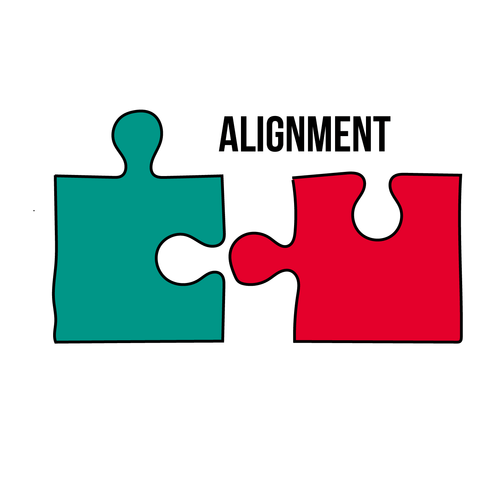
National Health Education Standards (NHES)
- 1.12.7 Compare and contrast the benefits of and barriers to practicing a variety of healthy behaviors such as getting good sleep.
- 7.12.3 Demonstrate a variety of healthy behaviors, such as getting good sleep, that avoid or reduce health risks to self and others.

- Instruction: In a group or think-pair-share format, have participants discuss the following questions. Acknowledge those who have progressed toward their goal(s) and encourage anyone who wants to change or modify their goal to get 1:1 support.
- Share: Let’s discuss our SMART Goals.
- How is it going with your current SMART goal?
- What are some ways you can improve progress towards your goal? (Grows)
- What are some ways you are doing well with progress towards your goal? (Glows)
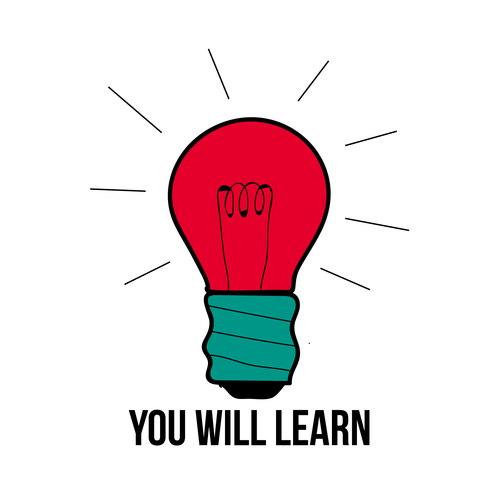
- Why sleep is important and how you can best prepare your body and mind for restful sleep.
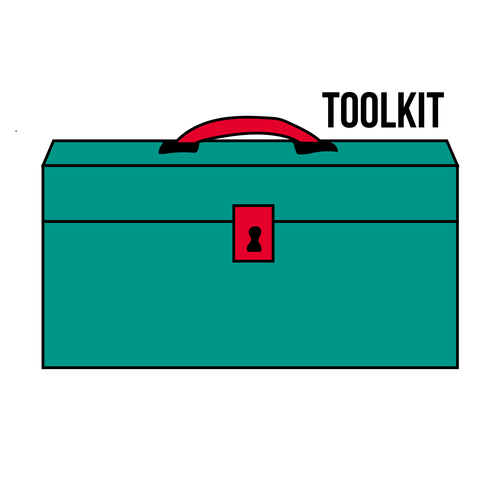
- Worksheets
- Slide presentation
- 4 Sleep Stations Handouts (more may be needed with large groups)
- Index cards with different numbers (0-12) on them
- Paper
- Writing utensils
- Dried lavender or lavender oil, lemon balm, dried calendula flowers, dried chamomile, and/or any other herbs that promote sleep
- Sachets
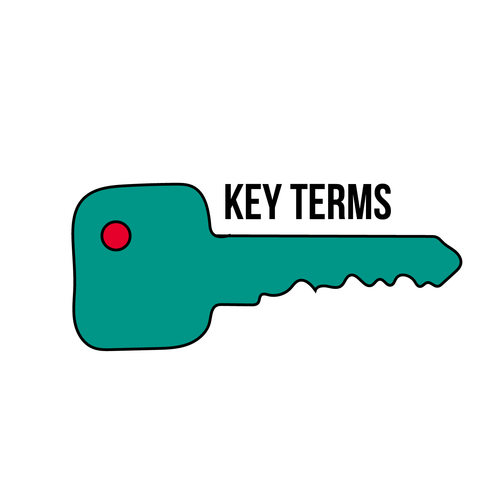
[As defined by AASM, n.d.; National Sleep Foundation, n.d.; Merriam-Webster Learner’s Dictionary, n.d.]
- Sleep Deprivation: A condition when an individual fails to get enough sleep.
- Melatonin: A hormone produced in the brain that promotes sleep. Light blocks melatonin production.
- Serotonin: A precursor to melatonin.
- Benefit: A good or helpful result or effect. or impossible
- Barrier: A problem that makes something
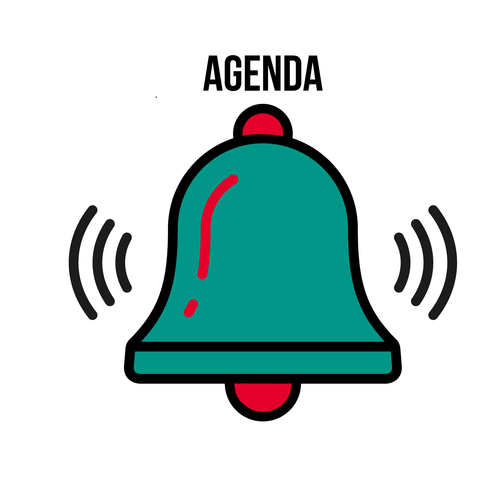
- Do Now
- Why So Sleepy?
- Stages of Sleep
- Sleep Stations
- Exit Ticket
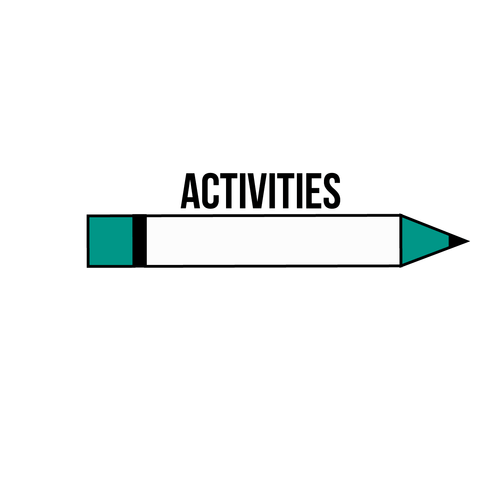
Do Now:
- Set-up:
- Post the following sleep increment signs around the room: No Sleep, 1-3 hours, 4-5 hours, 6-7 hours, 8-9 ½ hours, 10-11 ½, hours >12 hours.
- Share:
- Have you ever pulled an all-nighter? How did you feel the next day?
- Example answer: I felt tired and anxious and needed to drink caffeine to stay awake.
- Today we are going to talk about why sleep is important for your health and well-being and how you can best prepare your bodies and minds to get not only enough sleep but also continuous sleep throughout the night every night.
- Have you ever pulled an all-nighter? How did you feel the next day?
- Instruction:
- Have participants walk and stand next to the increment that they think is the answer to the following questions. Optional: Hold up each of the sleep increment signs one at a time and ask students to raise their hand to answer each of the following questions.
- How many hours of sleep did you get last night?
- How many hours of sleep do you get on the weekend?
- How many hours of sleep do you think you should get every night?
- Share:
- How much sleep do you think is recommended to get every night?
- Have participants walk and stand next to the increment that they think is the answer to the following questions. Optional: Hold up each of the sleep increment signs one at a time and ask students to raise their hand to answer each of the following questions.
- Instruction:
- Display the image below on in the presentation or worksheet on the projector or board.
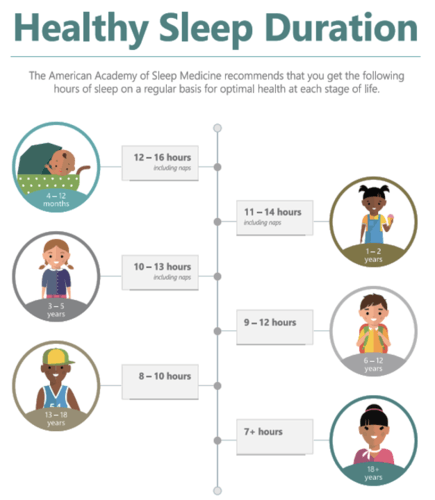 Image by The American Academy of Sleep Medicine
Image by The American Academy of Sleep MedicineShare:
- What happens when you do not get enough sleep? You experience sleep deprivation. Sleep deprivation is the condition when an individual fails to get enough sleep (AASM, n.d.).
Good to Know: Why So Sleepy?
- Instruction:
- Show the sleep deprivation diagram in the slide presentation or printed out on the projector or board.
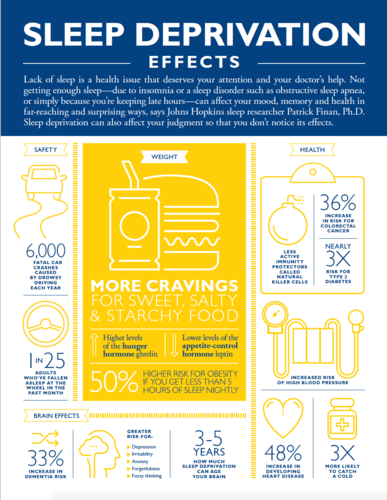 Image from: https://www.hopkinsmedicine.org/heal...eprivation.pdf
Image from: https://www.hopkinsmedicine.org/heal...eprivation.pdf- Optional: Play this video on the benefits of sleep: youtu.be/gedoSfZvBgE
- Share:
- Sleep deprivation can cause difficulties with appetite, learning, memory, thinking, and feelings, which may lead to poor school and work performance and difficulty with relationships (AASM, 2008).
- What are some strategies and tips that you could follow to improve your sleep?
- Instruction:
- Record answers on a projector, board or flipchart paper. Refer to tips on the worksheet or in the presentation. Responses may include:
- Stick to a sleep schedule:
- Get up at the same time every day, even on weekends or during vacations.
- If you don’t get enough sleep you can make it up the following day, but then sleep schedule will be off and you’ll continue the cycle.
- Set a bedtime that is early enough for you to get at least the recommended hours of sleep for your age.
- State of mind:
- Don’t go to bed unless you are sleepy.
- If you don’t fall asleep after 20 minutes, get out of bed.
- Establish a relaxing bedtime routine.
- Avoid intense, stimulating movies and TV shows and try reading which will exhaust your eyes.
- Try meditation and/or playing soothing music.
- The bedroom is for sleeping:
- Use your bed only for sleep, not for screen time, studying, etc.
- Make your bedroom a quiet and relaxing environment
- Keep the room at a comfortable, cool temperature because of your body temperature increases while you sleep which is why sometimes you do a “log pop” out from under your sheets – you are cooling off!
- Lights low and out:
- Limit exposure to bright light in the evenings.
- Turn off electronic devices at least 30 minutes before bedtime.
- Small portions of certain foods:
- Don’t eat a large meal before bedtime: if you are hungry at night, eat a light, healthy snack
- Avoid consuming caffeine or alcohol in the late afternoon or evening.
- Reduce your fluid intake before bedtime to limit the number of times you need to get up.
- Examples include warm milk, nuts, and fruits that contain serotonin or melatonin (such as kiwi, bananas, oranges, and pineapples). Melatonin is a hormone that promotes sleep that is affected by light (National Sleep Foundation, n.d.). Serotonin is a precursor to melatonin (National Sleep Foundation, n.d.).
- Exercise is great, but not too late:
- Exercise regularly well before you plan to go to sleep.
- Try to exercise 5-6 hours prior to sleeping since it helps you fall asleep. However, exercising 3 hours or less prior to bedtime may stimulate you.
- Stick to a sleep schedule:
- Record answers on a projector, board or flipchart paper. Refer to tips on the worksheet or in the presentation. Responses may include:
- Instruction:
- Ask participants to list why getting enough and consistent (without waking up too much) sleep is good for you (benefits), and why it may be hard to get good sleep (barriers).
- Also, ask participants to come up with a list of possible solutions to overcome the barriers.
- As participants share answers to the following questions, record answers on a projector, board or flipchart paper. Responses may include:
|
Benefits |
Barriers |
Strategies to overcome barriers |
|
Improves your overall health (initiates various healing processes, strengthens the immune system, etc.) |
Feeling stressed and/or anxious |
If you worry while trying to fall asleep, record your worries on a piece of paper and try to fall asleep again |
|
Improves your mood |
No time to sleep |
Prioritize sleep |
|
Improves your metabolism |
Do not feel sleepy at night because I still have too much energy |
Exercise during the day |
|
Strengthens your memory and keeps you more alert (which can help with academics, work, etc.) |
Falling asleep during the day and then not feeling tired at night |
Create and maintain a regular sleep schedule |
Sources:
- American Psychological Association. (n.d.). Why sleep is important. Retrieved From: www.apa.org/topics/sleep/why.aspx
- Griffin, RM. (2011). 9 surprising reasons to get more sleep. Retrieved From: https://www.webmd.com/sleep-disorder...o-sleep-more#3
Real World Relevance: Stages of Sleep
- Set Up:
- Create stage signs with fill in the blank. Show the word options or “word bank” in the presentation on the projector or written on the board. The words in bold are the suggested fill in the blank words.
- Stage 1
- Light sleep: between being awake and falling asleep
- Can wake up easily
- Eyes closed
- Leg twitch (Note: explain how your body confuses the act of your muscles relaxing with the sensation of falling)
- Lasts up to 7 minutes
- Stage 2
- Preparing for deep sleep
- Disengaged from surroundings
- Your heart and breathing rate still regular
- Body temperature drops
- Stage 3 & 4
- Deep sleep: most difficult to be woken up at this stage
- The body becomes less responsive to outside stimuli
- Repair and regenerate tissues, build bone and muscle, strengthen the immune system
- REM (Rapid Eye Movement)
- 90 minutes after fall asleep
- Heart and breathing rate increases and become erratic
- Possible to dream in stages 1-4, but most dreaming in 5th/final stage
- Intense dreaming due to heightened brain activity.
- Eyes moving back and forth like watching TV
- Share:
- Your brain is just as active if not more when you are asleep. It’s the time for your body to repair and rejuvenate from the day. Let’s learn about the five stages of sleep your body goes through the nights if you get enough and consistent sleep.
- Instruction:
- Select five volunteers to each hold one sign in front of the rest of the group. The fill-in-the-blank answers are on the back of the sign for the volunteer to read to the group after the group tries to answer.
- Share:
- After the REM stage, you should/can wake up, which is why you can remember your dream. On average, people typically go through 5-6 sleep cycles a night, and each cycle usually lasts around 90 minutes. If you do not wake up at the end of your dream/final stage, then you repeat the sleep cycle again. After your first sleep cycle, the amount of time you spend in stage 1 and 2 shortens dramatically while the amount of time you spend in stage 3 and 4 (the most important stages) grows (National Sleep Foundation, n.d.).
- Avoid substances, like alcohol, caffeine, and tobacco, that can affect your sleep cycles. Caffeine too late can make it hard to fall asleep. Meanwhile, alcohol and tobacco can chemically prevent your brain from entering stages 3 and 4, which means that consuming both of these things during the day don’t allow you to get a good, rehabilitating night’s sleep (Harvard Medical School, 2007).
Hands-On: Sleep Stations
- Set Up:
- Around the room, set up Sleep stations with signage, written instructions (Sleep Station Handouts), and any other materials listed in the toolkit.
- Instruction:
- Split participants into 4 groups.
- Each group will be assigned to begin at one station.
- After a certain amount of time, (suggest 5-15 minutes) signal (stopping of music playing, gong, whistle, etc.) groups to switch stations.
- Repeat until all the groups have visited each station.
- Prior to starting, go over the instructions for each station.
- Note: All of these stations could culminate in a sleeping kit that holds the pieces that the participants worked on during class.
- Optional: Play calming music for participants during this activity.
Sleep Station 1: DIY Sachets
- Share:
- Create a satchel by putting whichever herbs you like into the sachets. Examples such as dried lavender or lavender oil, lemon balm, dried calendula flowers, dried chamomile, etc.
- These herbs are thought to either promote sleep and/or reduce
- You can try to put the sachet you’ve created under your pillow to help you sleep at night.
Sleep Station 2: Sleep Scenarios
- Share:
- Choose one person to read each scenario out to the entire group. Then share your ideas on what the person in the scenario can do to improve their sleep.
- Scenario 1: Jose loves basketball. After work, Jose never goes directly home and plays basketball with his buddies. Every night Jose gets home around 8:30 PM, and since he is so hungry from the exercise, he cooks a big meal for himself. When he tries to go to sleep at 10 PM, he finds himself lying in bed trying everything and anything to fall asleep. His inability to sleep leads to exhaustion throughout the day, which causes Jose to feel more stressed. As you know, getting a good night’s sleep each night can greatly lower stress levels! How can Jose improve his sleep?
- He shouldn’t eat a large meal before bedtime. He can either get home earlier to eat (ideal) or eat a light snack.
- If he doesn’t fall asleep after 20 minutes, get out of bed.
- Scenario 2: Maribel loves to act and has been involved in theater since elementary school. Every day after work/school, she heads to her theater for rehearsal. Maribel usually arrives home at 7:00 PM. and drinks coffee hoping for a boost of energy to finish her work/homework. She does her work/homework on her bed and then tries to go to sleep around 10 PM. However, she always finds it hard to fall asleep. What can Maribel do to improve her sleep?
- She should avoid consuming caffeine in the late afternoon or evening
- She should also use her bed only for sleep
- Scenario 3: Alex always makes time to hang out with his friends. Because all his friends have different schedules, he never gets back home at the same time. As a result, on some days, he’ll go to sleep at 12 AM, and on other days he will go to bed at 9 PM. As he is preparing to sleep, Alex pulls out his phone to check social networks and chat with his friends, hoping that will help him doze Lately, Alex has been feeling more and more sleep deprived. How can Alex improve his sleep?
- He should turn off electronic devices at least 30 minutes before bedtime.
- He should keep a consistent sleep schedule. Maybe he can enforce a cut-off time for hanging out with friends so that he can get home around the same time every day.
Sleep Station 3: Mindful Breathing & Sleep
- Share:
- Using the handout, one person leads the rest of the group in the deep breathing and visualization exercise.
- If distracted, allow the thoughts to come in but escort them out again and refocus on the breathing.
- Compare how you feel before and after this exercise.
Sleep Station 4: Counting Reps Instead of Sheep
- Share:
- Compare how you feel before and after this exercise.
- As we’ve talked about, exercise helps promotes sleep.
- In this station, you will be doing some simple exercises (jumping jacks, squats, push-ups, high-knees, sit-ups) you can do at home.
- Remember that when you exercise is also important. Try to exercise 5-6 hours prior to sleeping since it helps you fall asleep. In contrast, exercising 3 hours or less prior to bedtime may stimulate you.
- Instruction:
- Demonstrate or select a participant to demonstrate each exercise once for the entire group.
- Note: This station may need to be held outside the room or in another room with more space.
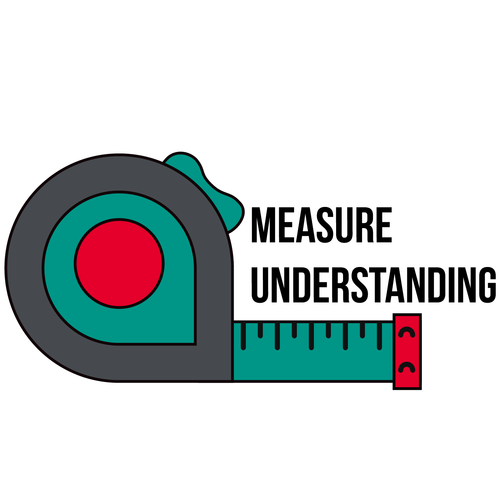
Exit Ticket:
- Instruction:
- Have participants write on their worksheet or share out loud the following question(s).
- Why are young people the most sleep-deprived?
- What are two things related to sleep that you want to know more about?
- What can you do to improve your sleep schedule?
- Have participants write on their worksheet or share out loud the following question(s).
Bibliography
- American Academy of Sleep Medicine. (2017). Healthy Sleep Habits. Retrieved From: http://www.sleepeducation.org/essentials-in-sleep/healthy-sleep-habits
- American Academy of Sleep Medicine. (n.d.). Sleep deprivation. Retrieved From: https://aasm.org/resources/factsheet...eprivation.pdf
- American Psychological Association. (n.d.). Why sleep is important. Retrieved From: www.apa.org/topics/sleep/why.aspx
- Griffin, RM. (2011). 9 surprising reasons to get more sleep. Retrieved From: https://www.webmd.com/sleep-disorders/features/9-reasons-to-sleep-more#3
- Harvard Medical School: Healthy Sleep. (2007). External factors influencing sleep. Retrieved From: http://healthysleep.med.harvard.edu/...ternal-factors
- Merriam-Webster Learner’s Dictionary. (n.d.). Barrier. Retrieved From: http://www.learnersdictionary.com/definition/barrier
- Merriam-Webster Learner’s Dictionary. (n.d.). Benefit. Retrieved From: www.learnersdictionary.com/definition/benefit
- National Sleep Foundation. (n.d.). Understanding sleep cycles. Retrieved From: https://sleep.org/articles/what-happens-during-sleep/
- National Sleep Foundation. (n.d.). Food and sleep. Retrieved From: https://sleepfoundation.org/sleep-to...food-and-sleep
- National Sleep Foundation. (n.d.). Melatonin and sleep. Retrieved From: https://sleepfoundation.org/sleep-topics/melatonin-and-sleep
- National Sleep Foundation. (n.d.). Food and drink that promote good sleep. Retrieved From: https://sleepfoundation.org/sleep-to...d-nights-sleep
- Ted-Ed. “The benefits of a good night’s sleep – Shai Marcu.” Retrieved From: youtu.be/gedoSfZvBgE
- National Institutes of Health. Melatonin: In Depth. Retrieved From https://nccih.nih.gov/health/melatonin

- Cleveland Clinic. (2014). 22 strange & fascinating facts about sleep. Retrieved From: https://health.clevelandclinic.org/2014/05/22-facts-about-sleep-that-will-surprise-you-infographic/
- “How to Sleep Better.” Retrieved From: https://www.youtube.com/watch?v=3eLfn7Ewx_s
- Optional Hands-On Activity: The Answer to Your Question Is…
- Instruction: Have each participant pick an index card that has either a question (Q) or answer (A). Have participants find their match. The Q’s will take their A’s and return to their seats. After participants are finished or 10 minutes, have each pair read out loud their Q&A’s.
This lesson was created in partnership with Albert Einstein College of Medicine Department of Epidemiology and Population Health with funding support by the National Institutes of Health NIDDK Grant R01DK097096.

